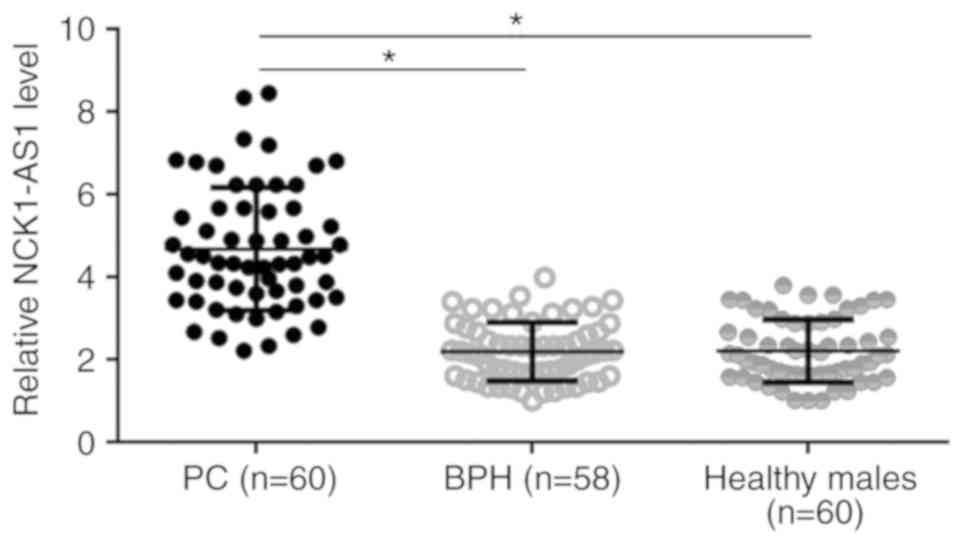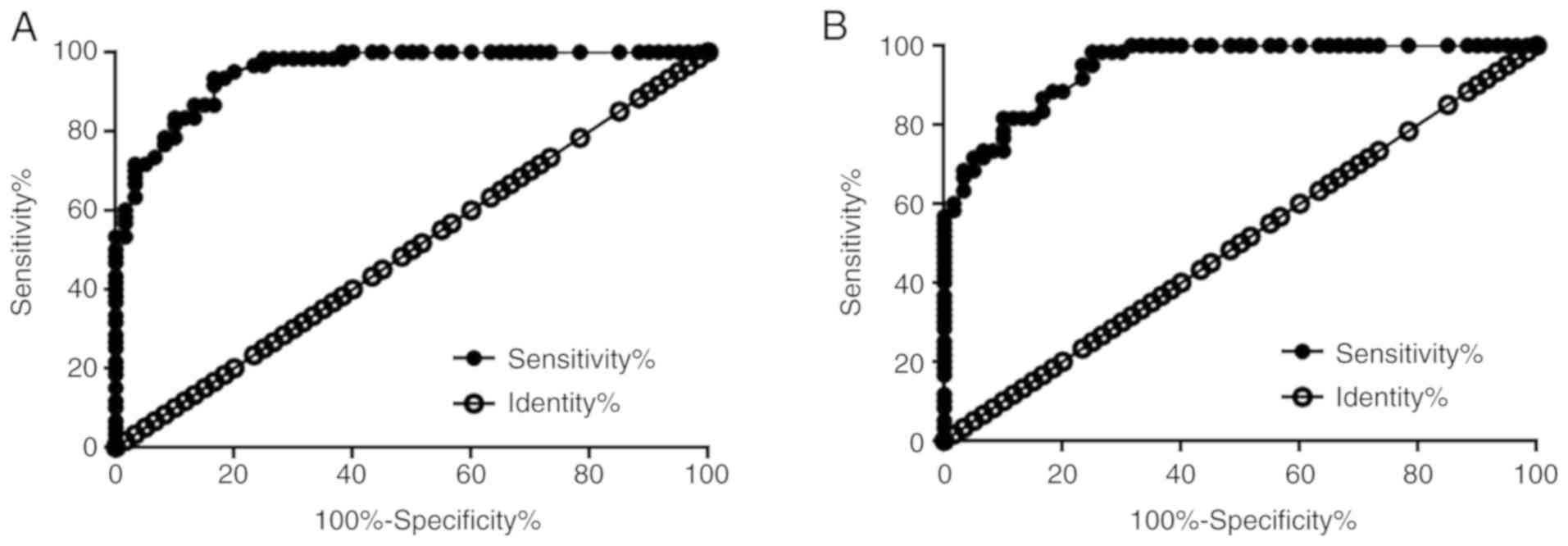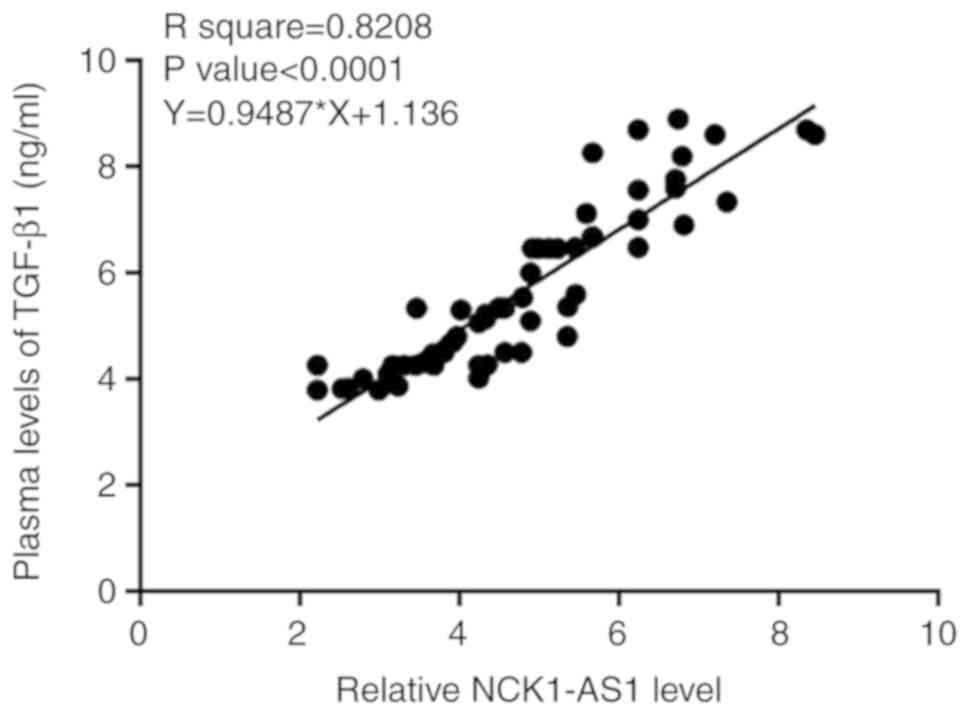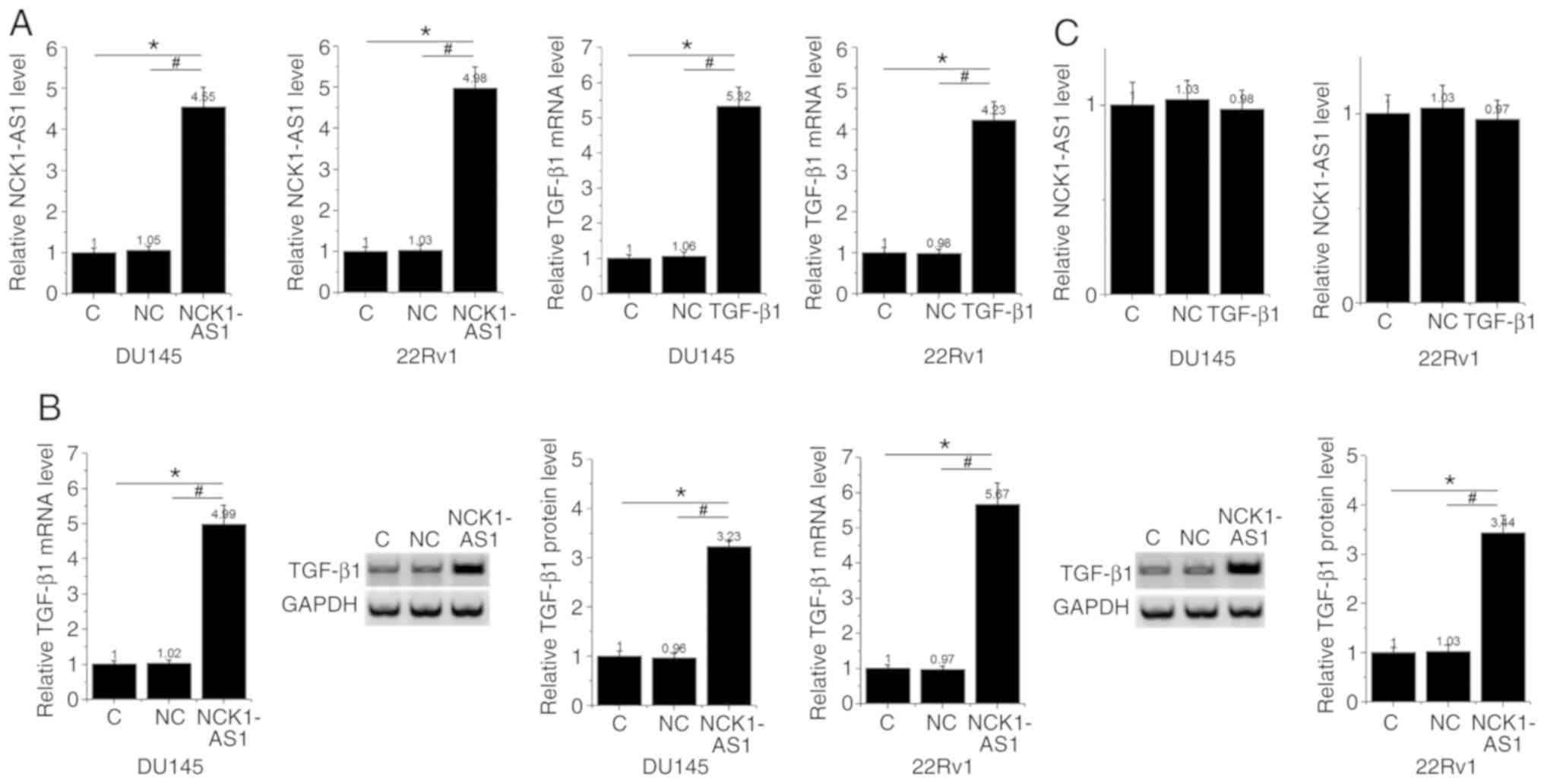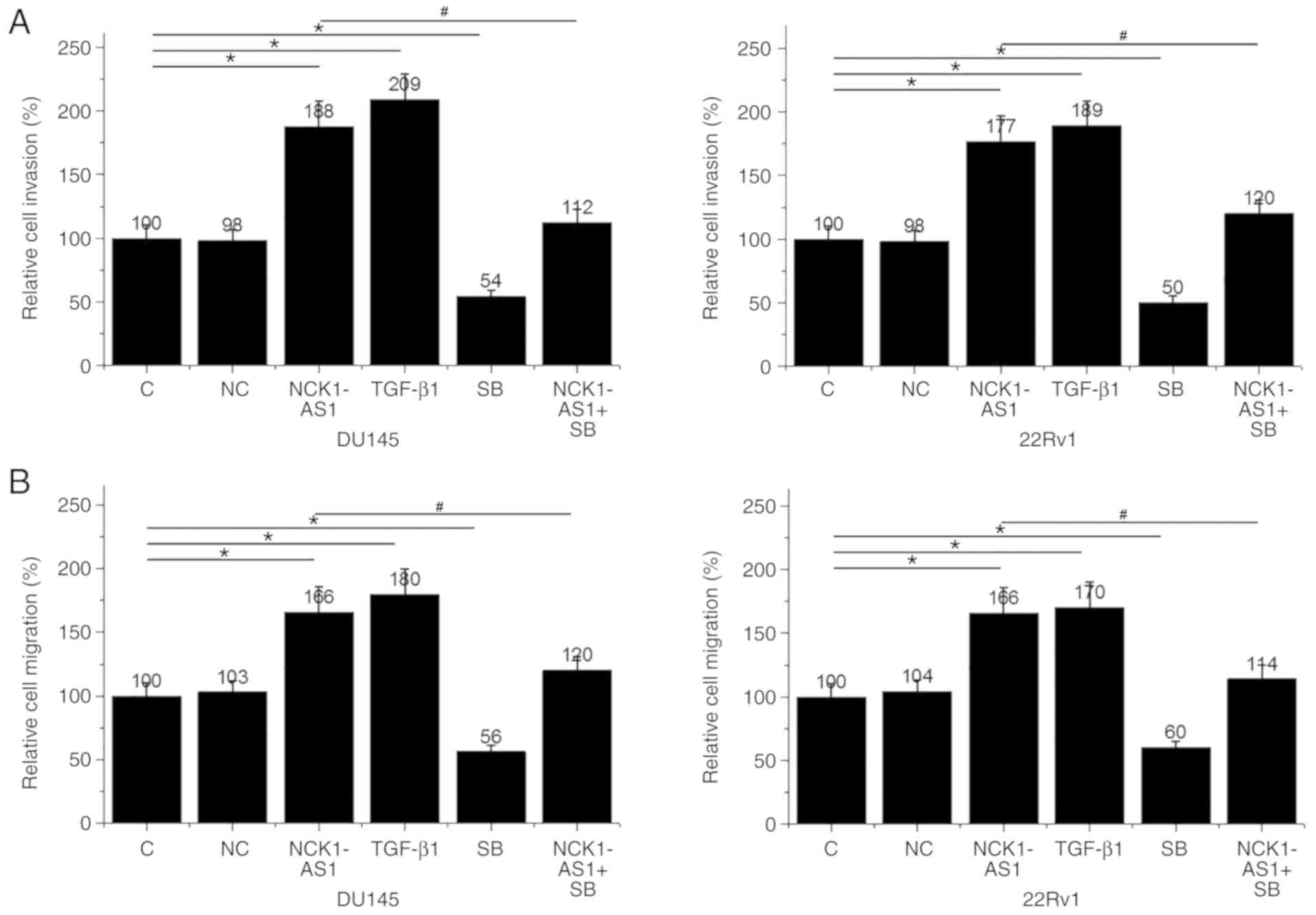Introduction
Prostate cancer (PC) is the most common type of
malignancy and the second major cause of cancer-associated
mortalities in males worldwide in 2018 (1). Due to its aggressive nature, PC can
develop rapidly and invade surrounding tissues, or even develop
into metastatic PC, leading to poor prognosis (2). The progression of PC is closely
correlated with dysregulated androgen receptor, and ablation of
androgen is the primary treatment method for PC (3,4).
However, castration-resistance will inevitably develop after 18–24
months of androgen deprivation (5).
Therefore, novel therapeutic approaches are required. However, the
molecular pathogenesis underlying PC remains unknown, which limits
the identification of novel therapeutic targets.
Long non-coding (lnc)RNAs (>200 nucleotides in
length), which are transcribed by RNA polymerase II, are RNA
transcripts that lack open reading frames, and thus encode no
proteins (6). Previous studies have
revealed that the major role of lncRNAs in diverse biological
processes is the regulation of gene expression (7,8). In
cancer biology, lncRNAs regulate the expression of oncogenes or
tumor suppressors to promote the inhibition of tumor development
(9). Thus, certain key
cancer-associated lncRNAs are considered promising targets for
cancer therapy (10). Therefore,
characterization of lncRNAs functions is required. NCK1 antisense
RNA 1 (NCK1-AS1) has been characterized as an oncogenic lncRNA in
cervical cancer (11). The present
study was performed with the aim of investigating the role of
NCK1-AS1 in PC.
Materials and methods
Research subjects
The research subjects of the present study included
60 male patients with PC, mean age 52.7±5.3 years (range, 44–64
years); 58 male patients with BPH, mean age 53.1±4.7 years (range,
43–65 years); and 60 healthy males, mean age 54.3±5.6 years (range,
44–65 years). All participants were diagnosed at The First
Affiliated Hospital of Soochow University (Suzhou, China) between
December 2015 and December 2018. The inclusion criteria of the
patients were as follows: i) New cases diagnosed by
histopathological examinations (blinded pathologists); ii) patients
had received no form of therapy prior to admission; iii) patients
had American Joint Committee on Cancer (AJCC) (12) stage I (n=24) or stage II (n=36). The
exclusion criteria of the patients were as follows: i) Any other
clinical disorders were observed, such as metabolic diseases and
inflammatory diseases; ii) patients had received a form of therapy
within 3 months prior to admission; iii) patients had a previous
history of malignancies; iv) patients had a family history of
malignancies. Based on the AJCC staging system, the 60 patients
with PC included 8, 12, 19 and 21 cases at clinical stage I, II,
III and IV, respectively. According to the Gleason grade (13), there were 6, 8, 12, 19 and 15 cases
at grades I, II, III, IV and V, respectively. All participants had
the principle experiment explained to them and written informed
consent was provided by all patients and healthy males. The present
study was approved by the Ethics Committee of The First Affiliated
Hospital of Soochow University.
Plasma and cells
Prior to the initiation of any therapies, fasting
blood (5 ml) was extracted from the basilic vein of all patients
with PC (n=60), patients with BPH (n=58) and healthy males (n=60).
Blood was transferred to EDTA-treated tubes and centrifuged for 15
min at 1,250 × g at room temperature to separate serum.
The present study included two human PC cell lines,
DU145 and 22Rv1 [American Type Culture Collection (ATCC)], and a
normal prostate cell line, RWPE-1 (ATCC). Cells were cultured in
Eagle's minimum essential medium [10% fetal bovine serum (FBS;
ATCC)] at 37°C and 5% CO2. Cells were collected at ~80%
confluence for subsequent experimentation.
Reverse transcription-quantitative PCR
(RT-qPCR)
Plasma (0.15 ml) or 105 DU145, 22Rv1 and
RWPE-1 cells were mixed with 1 ml Ribozol™ RNA Extraction Reagent
(Krackeler Scientific, Inc.) to extract total RNA. AMV Reverse
Transcriptase (Sigma-Aldrich; Merck KGaA) and SYBR Green Master Mix
(Bio-Rad Laboratories, Inc.) were used to perform the RT (at the
following conditions: 20 min at 50°C and 10 min at 80°C) or
preparing qPCR mixtures with 18S ribosomal (r)RNA or GAPDH as
endogenous control to analyze the expression of NCK1-AS1 or TGF-β1
mRNA, respectively. Sequences of primers were: NCK1-AS1 forward,
5′-TTCCCATTTCTCCCAGGTC-3′ and reverse, 5′-TGGTTACTTTGAGCCTGCC-3′;
GAPDH forward, 5′-GGAGCGAGATCCCTCCAAAA-3′ and reverse,
5′-GGCTGTTGTCATACTTCTCATG-3′; TGF-β1 forward,
5′-GGAGAGCCCTGGATACCAAC-3′ and reverse, 5′-CAACCCAGGTCCTTCCTAAA-3′;
and 18S rRNA forward, 5′-CTACCACATCCAAGGAAGC-3′ and reverse,
5′-TTTTCGTCACTACCTCCCCG-3′. The thermocycling conditions were as
follows: Initial denaturation at 95°C for 1 min, 40 cycles of 95°C
for 10 sec and 55°C for 40 sec. All experiments were repeated in
triplicate and quantified using the 2−ΔΔCq method
(14). The sample with the highest
ΔCq values was set to ‘1’, and all other samples were
normalized to this sample.
ELISA
TGF-β1 in plasma was detected via ELISA using Human
TGF-β1 Quantikine ELISA kit (cat. no. DB100B; R&D Systems,
Inc.). Levels of TGF-β1 were expressed as ng/ml.
Cell transient transfections
NCK1-AS1 and TGF-β1 expression vectors were
constructed by Sangon Biotech Co., Ltd. using a pcDNA3 vector.
DU145 and 22Rv1 cells were collected when they had reached 70–90%
confluence. Lipofectamine® 2000 reagent (Thermo Fisher
Scientific, Inc.) was used transfect 10 nM NCK1-AS1 or TGF-β1
expression vector, or 10 nM empty vector (negative control group;
NC) into 105 DU145 or 22Rv1 cells. This experiment also included
cells that had not undergone transfection to serve as control cells
(Control group; C). All subsequent experiments were performed using
cells collected at 24 h after transfection.
Measurement of cell migration and
invasion abilities
At 24 h after transfection, DU145 and 22Rv1 cells
were collected and 3×104 cells were mixed with 1 ml Eagle's Minimum
Essential Medium containing 1% FBS to prepare single cell
suspensions. In cases of TGF-β inhibitor treatment, SB431542 (10
nM; SB; Sigma-Aldrich; Merck KGaA) was added into the cell
suspensions. Matrigel (cat. no. 356234; EMD Millipore) was used to
coat the upper Transwell chamber membrane, and 0.1 ml cell
suspension was added. The lower chamber was filled with the
aforementioned medium containing 20% FBS. Cells were incubated at
37°C with 5% CO2 for 24 h, followed by staining of the
lower face of the membranes with 1% crystal violet (Sigma-Aldrich;
Merck KGaA) for 20 min at room temperature. The stained membranes
were observed under a light microscope to count the cells.
Western blotting
At 24 h after transfections, DU145 and 22Rv1 cells
were collected, and 2×105 cells were mixed with 1 ml RIPA solution
(Thermo Fisher Scientific, Inc.) for total protein extraction.
Following protein denaturation, the proteins were separated via
SDS-PAGE (10% gel; 30 µg per lane) and then transferred to PVDF
membranes. Following blocking in 5% non-fat milk (2 h at room
temperature), TGF-β1 (1:1,200; cat. no. ab92486) and GAPDH
(1:1,200; cat. no. ab9485) rabbit polyclonal primary antibodies
(both from Abcam) were incubated with the membranes at 4°C
overnight. After that, IgG-horseradish peroxidase-conjugated goat
anti-rabbit secondary antibody (1:1,000; cat. no. MBS435036;
MyBioSource, Inc.) was incubated with the membranes for 2 h at room
temperature. Finally, Pierce ECL Western Blotting Substrate
(Pierce; Thermo Fisher Scientific, Inc.) was used to develop
signals and Image J software (version 1.46; National Institutes of
Health) was used to analyze the data.
Statistical analysis
All data are presented as the mean ± standard
deviation, which were calculated using data from 3 biological
replicates of each experiment. Differences among 3 groups of
participants or different groups of cells were analyzed using
one-way analysis of variance (ANOVA) followed by Tukey tests.
Correlations were analyzed via linear regression. A receiver
operating characteristic (ROC) curve was used to analyze the
diagnostic values. P<0.05 was considered to indicate a
statistically significant difference.
Results
Plasma NCK1-AS1 is specifically
upregulated in patients with PC
Plasma NCK1-AS1 in patients with PC (n=60), patients
with BPH (n=58) and healthy males (n=60) was detected by performing
RT-qPCR, and the expression data were analyzed by performing
one-way ANOVA and Tukey tests. It was observed that the plasma
levels of NCK1-AS1 were significantly higher in the PC group than
in the other two groups (P<0.05; Fig.
1). However, no significant differences were observed between
patients with BPH and healthy males (Fig. 1). It is also worth noting that the
expression level of NCK1-AS1 was also significantly higher in DU145
(2.7-fold) and 22Rv1 (3.3-fold) cells than in RWPE-1 cells
(P<0.05; Fig. S1). Furthermore,
a slight increase in NCK1-AS1 levels alongside the increase of
Gleason score (Fig. S2A) and
clinical stages (Fig. S2B) was
observed, but these increases were not significant.
Upregulation of NCK1-AS1 distinguishes
patients with PC from patients with BPH and healthy males
The ROC curve analysis was performed to evaluate the
diagnostic value of plasma NCK1-AS1 for PC. Patients with PC were
used as true positive cases. For patients with BPH as true negative
cases, the area under the curve (AUC) was 0.95, with a standard
error of 0.017 and 95% confidence interval of 0.92–0.99 (Fig. 2A). With healthy males as true
negative cases, area AUC was 0.95, with a standard error of 0.018
and 95% confidence interval of 0.92–0.98 (Fig. 2B). The diagnostic value of TGF-β1 for
PC was analyzed by ROC, and the AUCs were 0.96 (standard error,
0.017; 95% confidence interval, 0.92–0.99) and 0.93 (standard
error, 0.019; 95% confidence interval, 0.91–0.97) in patients with
BPH (Fig. S3A) and healthy controls
(Fig. S3B), respectively, as true
negative cases.
TGF-β1 is positively correlated with
NCK1-AS1 in the plasma of patients with PC
TGF-β1 in the plasma of patients with PC was
detected via ELISA. The correlation between TGF-β1 and NCK1-AS1 in
the plasma of patients with PC was analyzed with linear regression.
As presented in Fig. 3, TGF-β1 and
NCK1-AS1 were positively and significantly correlated
(r2=0.8208; P<0.0001).
NCK1-AS1 is an upstream positive
regulator of TGF-β1
NCK1-AS1 and TGF-β1 expression vectors were
transfected into DU145 and 22Rv1 cells. Compared with the C and NC
control groups, the expression levels of NCK1-AS1 and TGF-β1 were
significantly increased at 24 h after transfection of NCK1-AS1 and
TGF-β1 expression vectors (P<0.05; Fig. 4A). Furthermore, overexpression of
NCK1-AS1 led to significantly upregulated TGF-β1 at both the mRNA
and protein levels (P<0.05; Fig.
4B), while TGF-β1 overexpression failed to significantly affect
NCK1-AS1 in PC cells (Fig. 4C).
NCK1-AS1 regulated PC cell migration
and invasion through TGF-β1
NCK1-AS1 and TGF-β1 overexpression resulted in
increased invasion (Fig. 5A) and
migration (Fig. 5B) rates of DU145
and 22Rv1 cells (all P<0.05). Treatment with TGF-β inhibitor
SB431542 (10 nM; SB; Sigma-Aldrich; Merck KGaA) for 24 h played an
opposite role and attenuated the effects of NCK1-AS1 overexpression
(P<0.05; Fig. 5).
Discussion
The expression pattern, function and clinical
potential of NCK1-AS1 for PC were systematically investigated in
the present study. It was revealed that NCK1-AS1 was upregulated in
PC and can be used to effectively distinguish PC from BPH and
healthy controls. In addition, NCK1-AS1 may upregulate TGF-β1 to
promote PC cell migration and invasion.
In the clinical practice, PC and BPH share similar
imaging characteristics. Previous studies have developed multiple
approaches to distinguish PC from BPH, such as genetic and
epigenetic markers (15) and
blood-based multiple marker detection (16). However, these approaches are limited
by the complicated operations and insufficient accuracy (15,16). Due
to the non-invasive nature, blood-circulating biomarkers, such as
lncRNAs, have indicated promising potential in the prediction of
disease (17). In the present study
it was observed that NCK1-AS1 was upregulated in the plasma of
patients with PC, and upregulation of NCK1-AS1 distinguished
patients with early stage (AJCC stage I and II) PC from patients
with BPH and healthy males. Therefore, NCK1-AS1 may be used to
assist with the early diagnosis of PC. Currently, biopsy is
considered the best option for clinical diagnosis; however,
biopsies are not practical in certain cases. Plasma markers are
less or non-invasive. Therefore, plasma NCK1-AS1 may be popularized
in clinical practices.
The TGF-β pathway is involved in the multiple
aspects of cancer development (18).
Inhibition of TGF-β signaling is a promising target for inhibiting
cancer metastasis (19). In the
present study, increased invasion and migration rate of PC cells
was observed following TGF-β overexpression, which confirmed the
enhancing effects of TGF-β on cancer metastasis. LncRNAs may
regulate TGF-β to participate in cancer biology (20). In the present study it was revealed
that NCK1-AS1 can upregulate TGF-β1 in PC cells, and the
upregulation of TGF-β1 by NCK1-AS1 is involved in the regulation of
PC cell migration and invasion. However, the molecular mechanism
underlying this interaction remains unclear. It is known that CDKs
can interact with TGF-β (21), while
NCK1-AS1 regulates CDK1 in the regulation of cell cycle progression
(22). Therefore, CDK1 may mediate
the interaction between NCK1-AS1 and TGF-β1. In addition, future
studies will focus on the interactions between NCK1-AS1 and NCK1,
which also have oncogenic functions (23).
Notably, NCK1-AS1 failed to affect PC cell
proliferation, while a recent study reported that NCK1-AS1 can
regulate cell cycle progression (22). This is potentially due to the
specific cell lines used in the present study. Prostate specific
antigen (PSA) has been widely used to distinguish PC and BPH, the
levels of which also increase in patients with BPH (24). In the present study, significant
differences in NCK1-AS1 levels between patients with BPH and
healthy controls were observed, indicating that NCK1-AS1 possesses
a higher accuracy. However, the present study failed to analyze
PSA, as PSA levels were not available for all patients.
In conclusion, NCK1-AS1 was upregulated in PC and
had screening potential. NCK1-AS1 may upregulate TGF-β1 to promote
PC cell migration and invasion.
Supplementary Material
Supporting Data
Acknowledgements
Not applicable.
Funding
No funding was received.
Availability of data and materials
The datasets used and/or analyzed during the present
study are available from the corresponding author upon reasonable
request.
Authors' contributions
ZG and YS designed the experiments, analyzed the
data and wrote the manuscript. JM, FL, XZ, GL and HA performed the
experiments and clinical research. JP performed the research design
and managed the project. All authors read and approved the final
manuscript.
Ethics approval and consent to
participate
Ethical approval was obtained from the Ethics
Committee of the First Affiliated Hospital of Soochow University.
All participants provided written informed consent.
Patient consent for publication
Not applicable.
Competing interests
The authors declare that they have no competing
interests.
References
|
1
|
Bray F, Ferlay J, Soerjomataram I, Siegel
RL, Torre LA and Jemal A: Global cancer statistics 2018: GLOBOCAN
estimates of incidence and mortality worldwide for 36 cancers in
185 countries. CA Cancer J Clin. 68:394–424. 2018. View Article : Google Scholar : PubMed/NCBI
|
|
2
|
Gundem G, Van Loo P, Kremeyer B,
Alexandrov LB, Tubio JMC, Papaemmanuil E, Brewer DS, Kallio HML,
Högnäs G, Annala M, et al: The evolutionary history of lethal
metastatic prostate cancer. Nature. 520:353–357. 2015. View Article : Google Scholar : PubMed/NCBI
|
|
3
|
Schweizer MT, Wang H, Luber B, Nadal R,
Spitz A, Rosen DM, Cao H, Antonarakis ES, Eisenberger MA, Carducci
MA, et al: Bipolar androgen therapy for men with androgen ablation
naive prostate cancer: Results from the phase II BATMAN study.
Prostate. 76:1218–1226. 2016. View Article : Google Scholar : PubMed/NCBI
|
|
4
|
Morgans AK, Chen YH, Sweeney CJ, Jarrard
DF, Plimack ER, Gartrell BA, Carducci MA, Hussain M, Garcia JA,
Cella D, et al: Quality of life during treatment with chemohormonal
therapy: Analysis of E3805 chemohormonal androgen ablation
randomized trial in prostate cancer. J Clin Oncol. 36:1088–1095.
2018. View Article : Google Scholar : PubMed/NCBI
|
|
5
|
Sun S, Sprenger CC, Vessella RL, Haugk K,
Soriano K, Mostaghel EA, Page ST, Coleman IM, Nguyen HM, Sun H, et
al: Castration resistance in human prostate cancer is conferred by
a frequently occurring androgen receptor splice variant. J Clin
Invest. 120:2715–2730. 2010. View
Article : Google Scholar : PubMed/NCBI
|
|
6
|
Mercer TR, Dinger ME and Mattick JS: Long
non-coding RNAs: Insights into functions. Nat Rev Genet.
10:155–159. 2009. View
Article : Google Scholar : PubMed/NCBI
|
|
7
|
Engreitz JM, Ollikainen N and Guttman M:
Long non-coding RNAs: Spatial amplifiers that control nuclear
structure and gene expression. Nat Rev Mol Cell Biol. 17:756–770.
2016. View Article : Google Scholar : PubMed/NCBI
|
|
8
|
Dykes IM and Emanueli C: Transcriptional
and post-transcriptional gene regulation by long non-coding RNA.
Genomics Proteomics Bioinformatics. 15:177–186. 2017. View Article : Google Scholar : PubMed/NCBI
|
|
9
|
Gutschner T and Diederichs S: The
hallmarks of cancer: A long non-coding RNA point of view. RNA Biol.
9:703–719. 2012. View Article : Google Scholar : PubMed/NCBI
|
|
10
|
Spizzo R, Almeida MI, Colombatti A and
Calin GA: Long non-coding RNAs and cancer: A new frontier of
translational research? Oncogene. 31:4577–4587. 2012. View Article : Google Scholar : PubMed/NCBI
|
|
11
|
Zhang WY, Liu YJ, He Y and Chen P:
Suppression of long noncoding RNA NCK1-AS1 increases
chemosensitivity to cisplatin in cervical cancer. J Cell Physiol.
234:4302–4313. 2019. View Article : Google Scholar : PubMed/NCBI
|
|
12
|
Edge SB and Compton CC: The American joint
committee on cancer: The 7th edition of the AJCC cancer staging
manual and the future of TNM. Ann Surg Oncol. 17:1471–1474. 2010.
View Article : Google Scholar : PubMed/NCBI
|
|
13
|
Epstein JI, Egevad L, Amin MB, Delahunt B,
Srigley JR, Humphrey PA and Grading Committee: The 2014
international society of urological pathology (ISUP) consensus
conference on gleason grading of prostatic carcinoma: Definition of
grading patterns and proposal for a new grading system. Am J Surg
Pathol. 40:244–252. 2016.PubMed/NCBI
|
|
14
|
Livak KJ and Schmittgen TD: Analysis of
relative gene expression data using real-time quantitative PCR and
the 2(-Delta Delta C(T)) method. Methods. 25:402–408. 2001.
View Article : Google Scholar : PubMed/NCBI
|
|
15
|
Sanchez BE, Aguayo A, Martinez B,
Rodríguez F, Marmolejo M, Svyryd Y, Luna L, Muñoz LA, Jiménez MA,
Sotomayor M, et al: Using genetic and epigenetic markers to improve
differential diagnosis of prostate cancer and benign prostatic
hyperplasia by noninvasive methods in Mexican patients. Clin
Genitourin Cancer. 16:e867–e877. 2018. View Article : Google Scholar : PubMed/NCBI
|
|
16
|
Leidinger P, Hart M, Backes C, Rheinheimer
S, Keck B, Wullich B, Keller A and Meese E: Differential
blood-based diagnosis between benign prostatic hyperplasia and
prostate cancer: miRNA as source for biomarkers independent of PSA
level, gleason score, or TNM status. Tumour Biol. 37:10177–10185.
2016. View Article : Google Scholar : PubMed/NCBI
|
|
17
|
Qi P, Zhou XY and Du X: Circulating long
non-coding RNAs in cancer: Current status and future perspectives.
Mol Cancer. 15:392016. View Article : Google Scholar : PubMed/NCBI
|
|
18
|
Derynck R, Akhurst RJ and Balmain A:
TGF-beta signaling in tumor suppression and cancer progression. Nat
Genet. 29:117–129. 2001. View Article : Google Scholar : PubMed/NCBI
|
|
19
|
Yingling JM, Blanchard KL and Sawyer JS:
Development of TGF-beta signalling inhibitors for cancer therapy.
Nat Rev Drug Discov. 3:1011–1022. 2004. View Article : Google Scholar : PubMed/NCBI
|
|
20
|
Li Z, Dong M, Fan D, Hou P, Li H, Liu L,
Lin C, Liu J, Su L, Wu L, et al: LncRNA ANCR down-regulation
promotes TGF-β-induced EMT and metastasis in breast cancer.
Oncotarget. 8:67329–67343. 2017.PubMed/NCBI
|
|
21
|
Alarcón C, Zaromytidou AI, Xi Q, Gao S, Yu
J, Fujisawa S, Barlas A, Miller AN, Manova-Todorova K, Macias MJ,
et al: Nuclear CDKs drive Smad transcriptional activation and
turnover in BMP and TGF-beta pathways. Cell. 139:757–769. 2009.
View Article : Google Scholar : PubMed/NCBI
|
|
22
|
Li H, Jia Y, Cheng J, Liu G and Song F:
LncRNA NCK1-AS1 promotes proliferation and induces cell cycle
progression by crosstalk NCK1-AS1/miR-6857/CDK1 pathway. Cell Death
Dis. 9:1982018. View Article : Google Scholar : PubMed/NCBI
|
|
23
|
Xia P, Huang M, Zhang Y, Xiong X, Yan M,
Xiong X, Yu W and Song E: NCK1 promotes the angiogenesis of
cervical squamous carcinoma via Rac1/PAK1/MMP2 signal pathway.
Gynecol Oncol. 152:387–395. 2019. View Article : Google Scholar : PubMed/NCBI
|
|
24
|
Benson MC, Whang IS, Pantuck A, Ring K,
Kaplan SA, Olsson CA and Cooner WH: Prostate specific antigen
density: A means of distinguishing benign prostatic hypertrophy and
prostate cancer. J Urol. 147:815–816. 1992. View Article : Google Scholar : PubMed/NCBI
|















